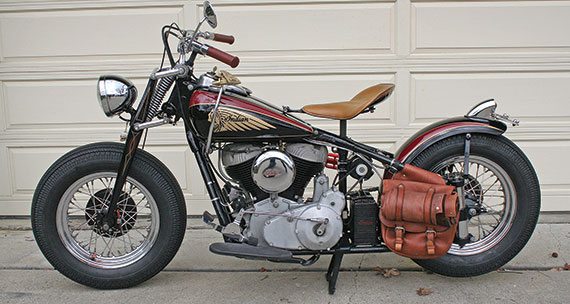
Look up “bobber” in a conventional dictionary, and the definition talks about a float on a fishing line. Try Wikipedia: “A bobber is a custom motorcycle that usually has the front fender removed, the rear fender ‘bobbed’ (made smaller), and all superfluous parts removed to reduce weight.”
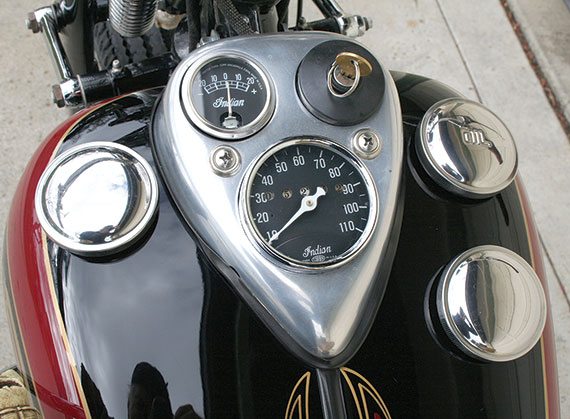
Conventional wisdom states that motorcycle bobbers originated after World War II, when returning servicemen wanted to make their stock bikes look a little sportier, a little racier. It was easy to remove the front fender, and the rear fender usually had a flip-up bit at the end that could be easily detached. These flip-ups were intended to facilitate fixing flat tires, in the days when inner tubes weren’t as tough as ones available now. Tire goes flat, stop, hoist the bike up onto the rear-wheel stand, which pivoted off near the axle and lifted the wheel into the air, loosen a couple of nuts on the fender to flip up the tail piece, pull the axle out, and the rear wheel could be rolled backwards.
Actually one should go back 10 years and take a look at the bikes running flat-track ovals, which was the popular racing in the 1930s, be it at Hollister, California, or Daytona Beach, Florida. The Great Depression had hurt the motorcycle industry a great deal, and the specialized racing bikes that the factories used through the 1920s were financial black holes. So, in 1932, Harley and Indian got together with the AMA, which ran all official races, and set up Class C racing, which meant only production motorcycles were allowed to race for championships. The A and B classes, which had factory and aftermarket backing, virtually disappeared. The purists were aghast at this downgrading of racing machines, but the new populist notion soon took off, because winning races could now be done on the cheap. To show how serious the AMA was about using street bikes, initially riders had to actually ride their bikes on the highways to the tracks, and then prep them for the race. That only lasted a short time.
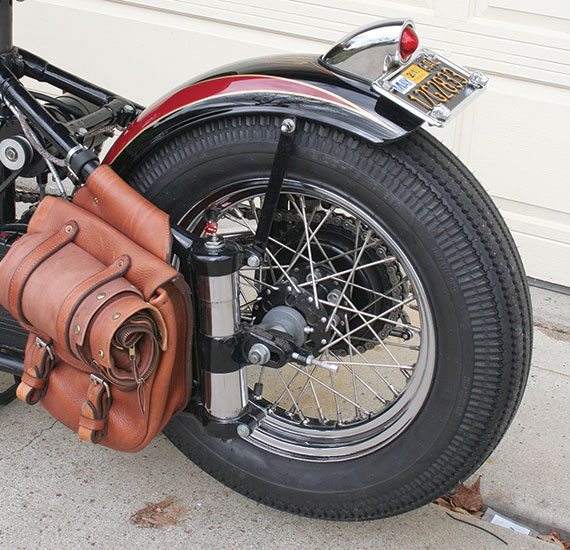
Look at photos of the 1930s and those bikes whipping around the track are mostly bobbed, both to reduce weight and to limit damage in case of the frequent falls. The most popular racing was in the 45-inch class, Indian Scouts against Harley RLs and WLs. Then the war came, and everything was focused on it until the victory over the Axis forces and the troops came home, and motorcycle riding and racing got underway again. Some of these postwar fellows liked the bobbed look…although this did mean getting really wet when it rained. The “bobber” notion, as a styling concept, has never fully gone away, and with the current passion for nostalgia, classic bobbers are now appearing.
Bobbing a ’47 Indian Chief required a little bit of thinking. Post-1940 Indians weren’t easy to bob as they had the hugely valanced fenders, and the flip-up bit had disappeared. Along with the rear-wheel stand, which was replaced by what was one of the first centerstands. Hoisting one of these 550-pound behemoths onto its poorly pivoted centerstand was a job for a couple of strong lads, unless one did it the proper way. Lean the bike way over on the sidestand, lower the centerstand by hand, than tilt the bike back up on the centerstand. Very cool.
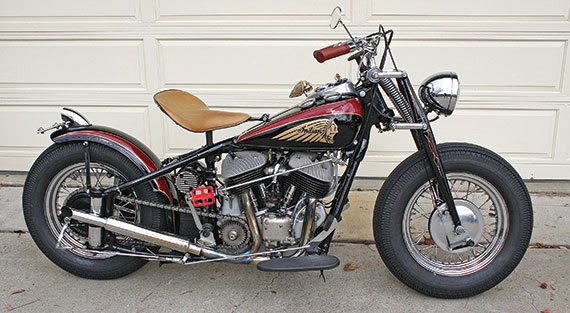
The owner of this bike rode it as a full-dress Chief for many years, until one day he decided to go bobber. Front fender went away, easy. The rear? Ted found a fender off an Indian 741 Scout which he trimmed and shortened for a bobber look, and used that to replace the big fender, along with a period taillight. He also located a Scout muffler to make the lines a little lighter, a little trimmer. Don’t worry, the original full-skirted fenders and all the other bits and pieces are safely stashed away, and the bike can go back to stock in a few hours.
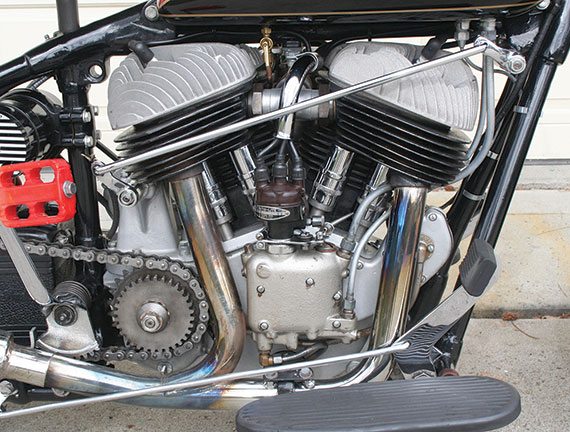
Ted does a lot of miles on his bobber, so power and reliability were an issue. He stroked the 74-inch engine to 80 inches, buying a pair of flat heads from Kiwi Indian in California that accommodate the extra stroke. In order to make this more suitable for open-road touring, he changed the front sprocket from 24 teeth to 26, giving him lower revs at a comfortable 65 or 70 mph.
The electrical system was altered to 12 volt, and a Petronix electronic ignition now sparks the two plugs. Cycle Electric provided the generator, which fits nicely in the original generator housing, and there is a solid-state voltage regulator. To a casual viewer, none of these changes are viewable—just the way Ted wants it.
Suspension is stock, with the new (for 1946) girder front fork replacing the rather unaesthetic leaf-spring design that had been in use for over three decades. In addition to being substantially lighter, the girders offered considerably more travel than the old leaf springs. And while Indian was very proud of its “sprung frame,” the rear plunger shocks provided less than two inches of movement. However, these were better than a hardtail. The real salvation was the well-sprung saddle, which made it an all-day rider.
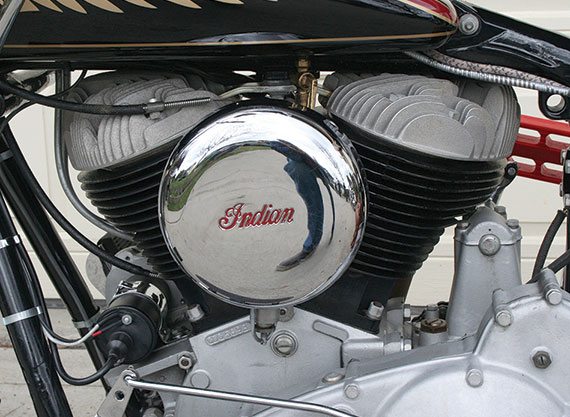
Gas on, ignition on, choke the Linkert carb, retard the spark (on left grip), rise up high on the kickstarter and come down hard! Vroom! Nice sound. Engine settles in, disengage the foot clutch, put the left-hand gearshift into first, engage the clutch, and Ted’s away. Ten miles, 100 miles, 1,000 miles…the bobber is happy to go.








